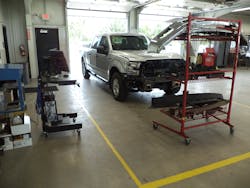SHOP: Shelton Collision Repair LOCATION: Derby, Kan. OWNER: Brad Shelton SIZE: 12,500 square feet STAFF SIZE: 14 AVERAGE MONTHLY CAR COUNT: 115 ANNUAL REVENUE: $2.5 million
What It Is:
Stall lines on the shop floor that outline each of the shop’s 15 bays. These stall lines serve as a rudimentary step that is part of the shop’s overall organizational practices.
The Inspiration:
Brad Shelton, owner of Shelton Collision Repair, moved his operation to this facility in Derby, Kan., almost five years ago.
When he started building out his new shop, he wanted to promote organization and cleanliness within his team on the shop floor. He also wanted to make sure that as vehicles go through the repair process, the vehicle and its components all stay within their designated space. Thus, there would be no opportunity for vehicle parts or shop tools to get lost or misplaced.
He’s seen other shops that have stall lines and he decided to add that component to his shop floor. Shelton notes that it is fairly common for shop owners to have them in their shops.
What It Does:
The yellow, parallel stall lines delineate each stall and vehicle’s “area.” Each technician works within the confines of that space and keeps their equipment within the area demarcated by the yellow lines on the shop floor.
The stall lines help keep each technician’s work space from colliding with someone else’s work. Shelton holds firm that “whatever happens within those lines, stays in those lines.”
How It’s Made:
Shelton used yellow, industrial rubber adhesive tape that he purchased online to create the stall lines.
When Shelton took ownership of the Derby facility, it was one of the first things he added to the building. After mapping out each 14 foot wide by 24.5 foot long stall, he marked on the floor each set of parallel lines for all 15 stalls.
The Cost:
Shelton said the rubber adhesive tape, which he purchased online, ran him about $400–$500.
He mentioned that the stall lines have held for the last five years and he’ll replace them soon. Others have stall lines painted directly on the shop floor and Shelton decided to use tape instead because it is easier and cheaper to go with the tape. And, the industrial grade tape lasts longer than painted lines so he doesn’t have to spend more to have them redone every so often.
The ROI:
Overall, Shelton notes that having these stall lines helps his team stay organized. This results in time savings and boosted overall efficiency. Technicians aren’t wasting time trying to figure out which tools belong to them and service advisors are able to clearly identify who is working on which car. The shop’s touch time stands at 4.15 hours per production day and all technicians average 145 percent efficiency.
He also saw a difference in how things were organized and kept within the areas between the stall lines.
“Before the lines our stall sizes varied depending on the tech and how much space they felt they needed,” Shelton says. “Now, cars are pulled in straight; parts and tool carts are kept within the area’s boundaries; and material or adhesive carts are shared between stalls.”

